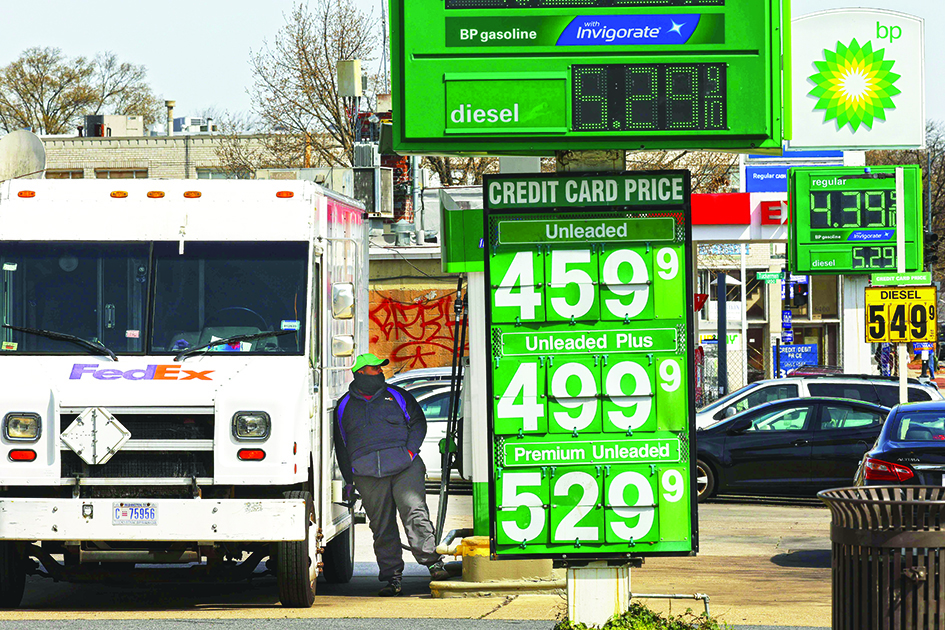WASHINGTON: US inflation continued to surge in March, sending the consumer price index (CPI) up 8.5 percent over the past 12 months, its largest increase in more than four decades, the Labor Department said Tuesday. Compared to February, prices climbed 1.2 percent, in line with analysts' forecasts, though "core" CPI, which excludes volatile food and energy prices, rose 0.3 percent, less than expected.
The report was the first to fully encompass the shock caused by Russia's invasion of Ukraine and the West's sanctions against Moscow, which have caused energy and food prices to spike worldwide. US gasoline prices soared 18.3 percent in the month, accounting for about half the increase in overall CPI. Total energy prices increased 11 percent compared to February, which included a 22.3 percent jump in fuel oil prices, the report said.
Other components driving the price surge were food, which rose one percent, and shelter, including rents, which climbed 0.5 percent. Both monthly increases were the same as in February. Airfares rose 10.7 percent, but used cars prices, which surged in 2021 as the US economy recovered from the pandemic, dropped 3.8 percent.
Americans have been weathering steadily accelerating price increases that hit 7.9 percent over the 12 months to February, a rate not seen in four decades. But as the Federal Reserve raises interest rates, some economists believe the report will also mark the peak of the inflation wave that began last year as the economy recovered from COVID-19 -- though it could be a while before consumers feel relief.
"The subsequent slowing may not be meaningful given all the supply restrictions on products from Russia and Ukraine as well as the growing supply chain bottlenecks on finished goods from China due to the COVID lockdowns there," Karl Haeling of LBBW said.
The inflation wave has become a political liability for President Joe Biden, and before the data's release, the White House temporarily waived a seasonal ban on sales of E15 gasoline, which is cheaper but usually not allowed to be sold during the summer. But that won't stop the Labor Department from reporting another sky-high year-on-year inflation number in March that analysts believe could hit somewhere around 8.5 percent.
Nearing the peak?
After years of muted price pressures, inflation began climbing as the economy recovered a year ago, driven by the Fed's pandemic-era easy money policies, global shortages of components and delays in shipping, and government stimulus packages that fattened Americans' wallets and drove up demand. The consensus among economists is for CPI to accelerate by 1.2 percent in March compared to February, but for "core" CPI, which excludes volatile food and energy prices, to rise by 0.5 percent in March, the same as the month prior.
Ian Shepherdson of Pantheon Macroeconomics predicted "this will be the peak" of the annual increases-but only because future reports will be compared to months in 2021 when prices were already climbing. Gasoline will play a big role in March's price gains, Shepherdson said, adding 0.7 percent to the monthly figure overall. Food prices also rose in the month, he said, as did hotel prices and airfares, though prices for scarce used cars may decline after recent surges.
Hitting demand
While analysts are skeptical that the White House's moves to cut pump prices will be effective, a recent decline in global oil prices may ultimately take some pressure off Americans. Meanwhile, the Fed is moving to tighten lending conditions to stop inflation, though whether they can do so without causing a recession is an open question. The central bank hiked interest rates a quarter-point higher from zero last month, and are widely expected to raise them by a half-point next month, and continue increasing throughout this year. "There is no road map for what the Fed is trying to accomplish except in world (with) supply constraints," Grant Thornton economist Diane Swonk warned on Twitter. The "Fed needs to hit demand. Hard. Very hard," she wrote. - AFP











